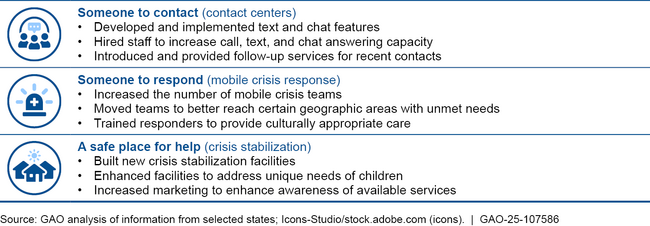Behavioral Health: Federal Activities to Support Crisis Response Services
Fast Facts
Millions of Americans are affected by behavioral health conditions, including mental health conditions and substance use disorders. People in crisis may be at risk of harming themselves or others.
The Substance Abuse and Mental Health Services Administration provides resources, including over $1.3 billion from FY 2021-2024, to states and others for crisis response services.
We reviewed how states used SAMHSA resources for crisis response efforts such as:
- Enhancing a crisis hotline that links people in crisis to a counselor
- Providing mobile crisis response units
- Hiring more response staff
- Improving access to services in hard-to-reach areas

Highlights
What GAO Found
The Substance Abuse and Mental Health Services Administration (SAMHSA), an agency within the Department of Health and Human Services (HHS), has worked to reduce the effect of mental illness and substance use disorders—collectively referred to as behavioral health conditions. A behavioral health crisis, which can happen to anyone, puts an individual at risk of hurting themselves or others. Crisis response services can reduce the risk of immediate harm and help prevent future crises by providing access to behavioral health providers.
GAO found that from 2020 through May 2025, SAMHSA provided resources—guidance, funding, and technical assistance—to states and others, such as behavioral health clinics, to support crisis response services. For example,
- Guidance. SAMHSA issued guidance outlining best practices for providing crisis response services. In it, SAMHSA described the importance of offering a range of services across a continuum of care, which includes (1) someone to contact—contact centers, (2) someone to respond—mobile crisis teams, and (3) a safe place for help—crisis stabilization.
- Funding. GAO found that SAMHSA provided over $1.3 billion through 10 programs in fiscal years 2021 through 2024 to support states and others in developing and providing crisis response services. Five programs supported the 2022 launch of the 988 Suicide & Crisis Lifeline—an easy-to-remember phone number that links those in crisis to a counselor. Other programs provided funding to support mobile crisis teams that provide in-person treatment and assessment.
- Technical assistance. SAMHSA offered trainings, expert panels, and other assistance to help states enhance their crisis response services.
The five selected states in GAO's review used SAMHSA resources to support behavioral health crisis response services in a variety of ways across the continuum of care through May 2025. For example, officials from all five states said they used SAMHSA funding to hire staff to increase responsiveness to individuals in crisis. Others invested in infrastructure such as by building data-sharing platforms to help improve care coordination, according to state officials.
Examples of Selected States' Use of Federal Resources to Enhance Behavioral Health Crisis Response Services Across the Continuum of Care

Note: For more details, see fig. 2 in GAO-25-107586.
Why GAO Did This Study
Behavioral health conditions affect millions of Americans, and these numbers continue to grow. GAO has reported on multiple nationwide behavioral health issues, including longstanding shortages in the behavioral health provider workforce. Delays in accessing behavioral health care have been common and may increase the risk that an individual experiences a crisis.
SAMHSA has provided resources, such as funding, to states and others to enhance behavioral health services, including crisis response services. In March 2025, HHS announced that it would consolidate SAMHSA into a new Administration for a Healthy America. As of August 25, 2025, this transition had not yet occurred.
The Consolidated Appropriations Act, 2023, includes a provision for GAO to review SAMHSA's behavioral health crisis response programs. Among other things, this report describes SAMHSA's behavioral health crisis response efforts and how selected states used SAMHSA resources to support their crisis response activities through May 2025.
GAO reviewed SAMHSA data and documentation from 2020 through May 2025, and interviewed agency officials. GAO also reviewed documentation and interviewed behavioral health department officials from five states. These states—Arizona, Georgia, Oklahoma, Virginia, and Washington—were selected to reflect geographic variation among those with a high capacity to respond to crisis response needs in their state.
For more information, contact Alyssa M. Hundrup at HundrupA@gao.gov.
